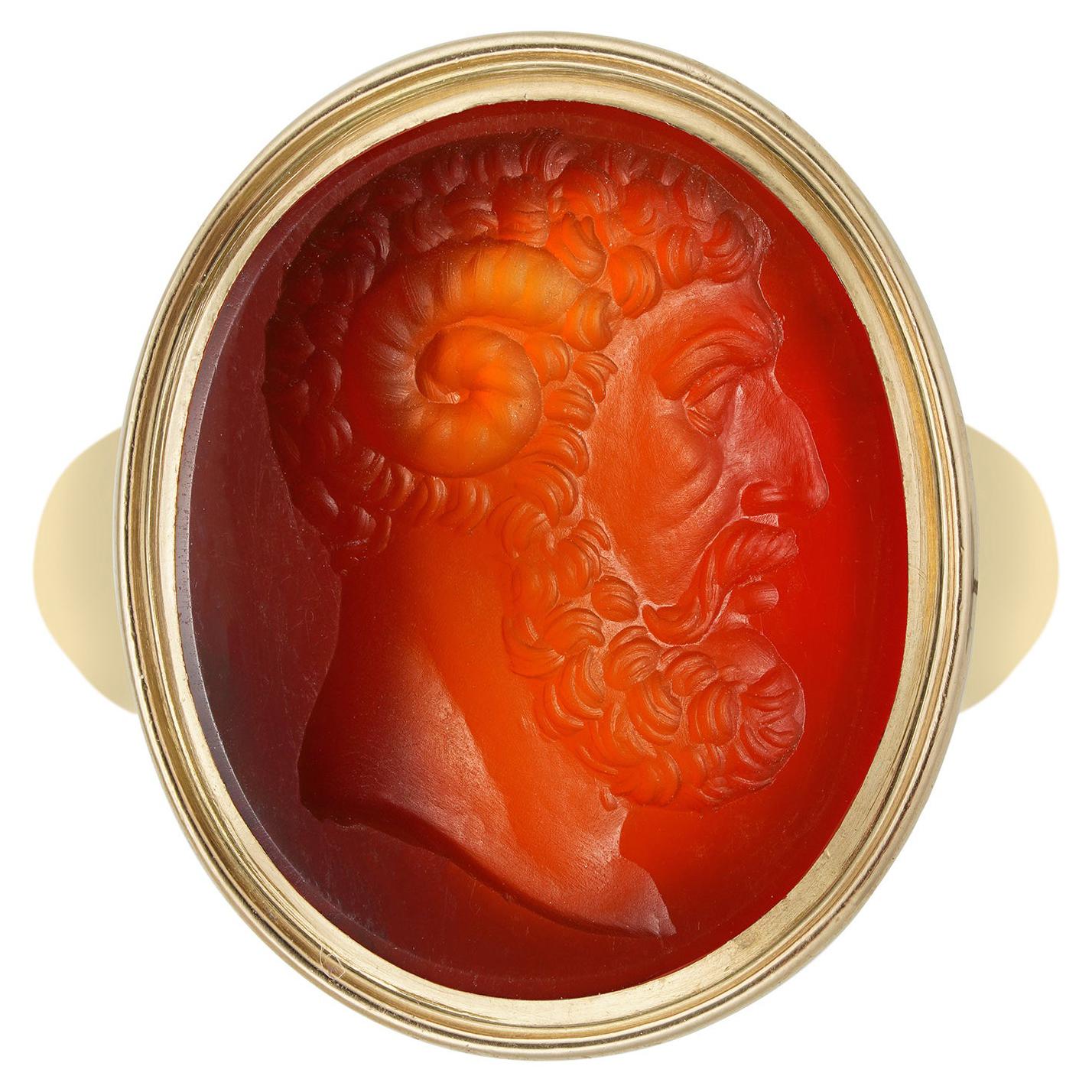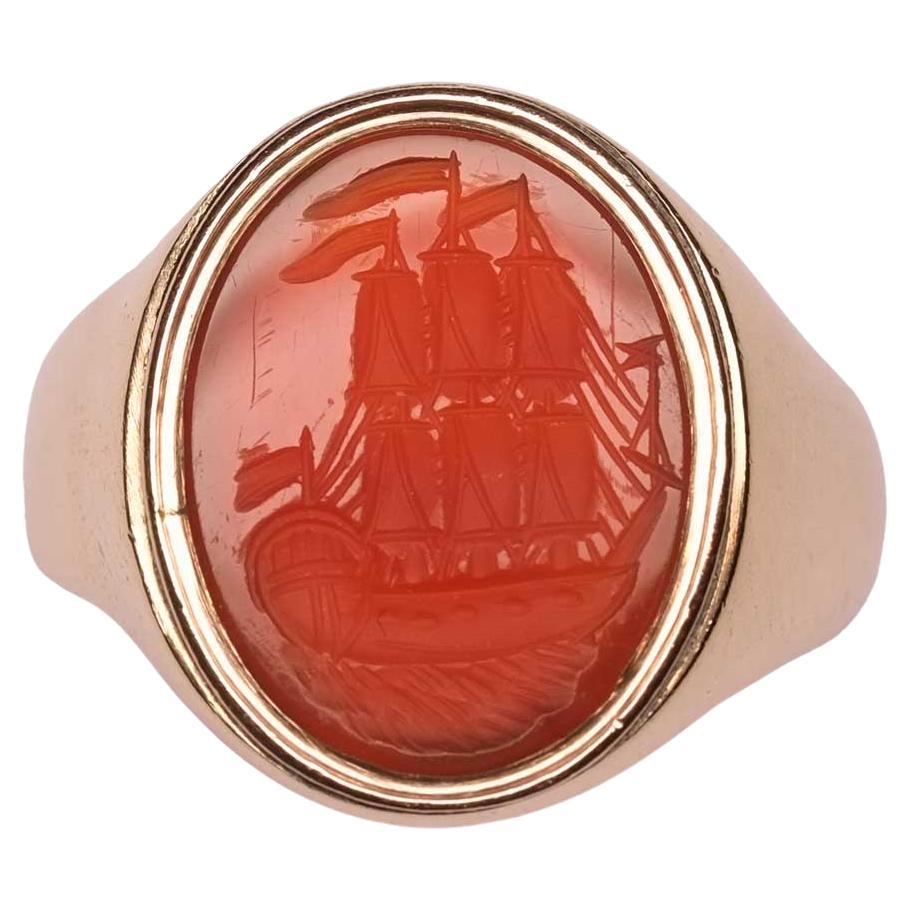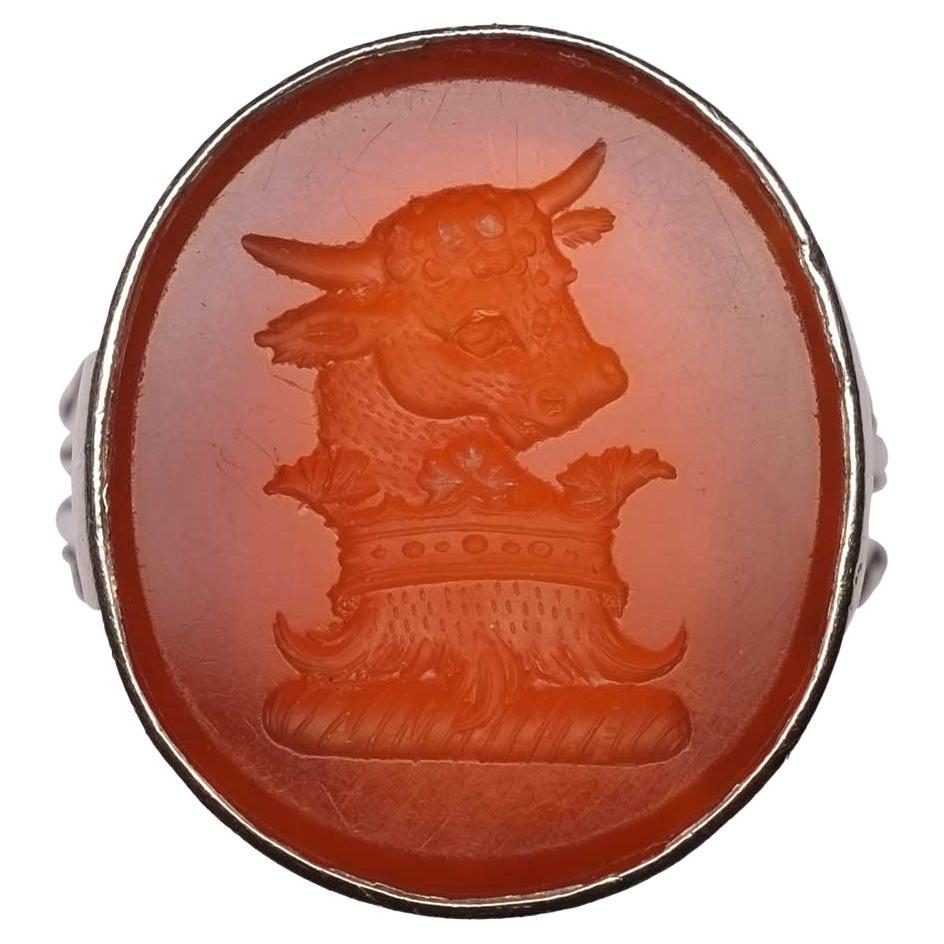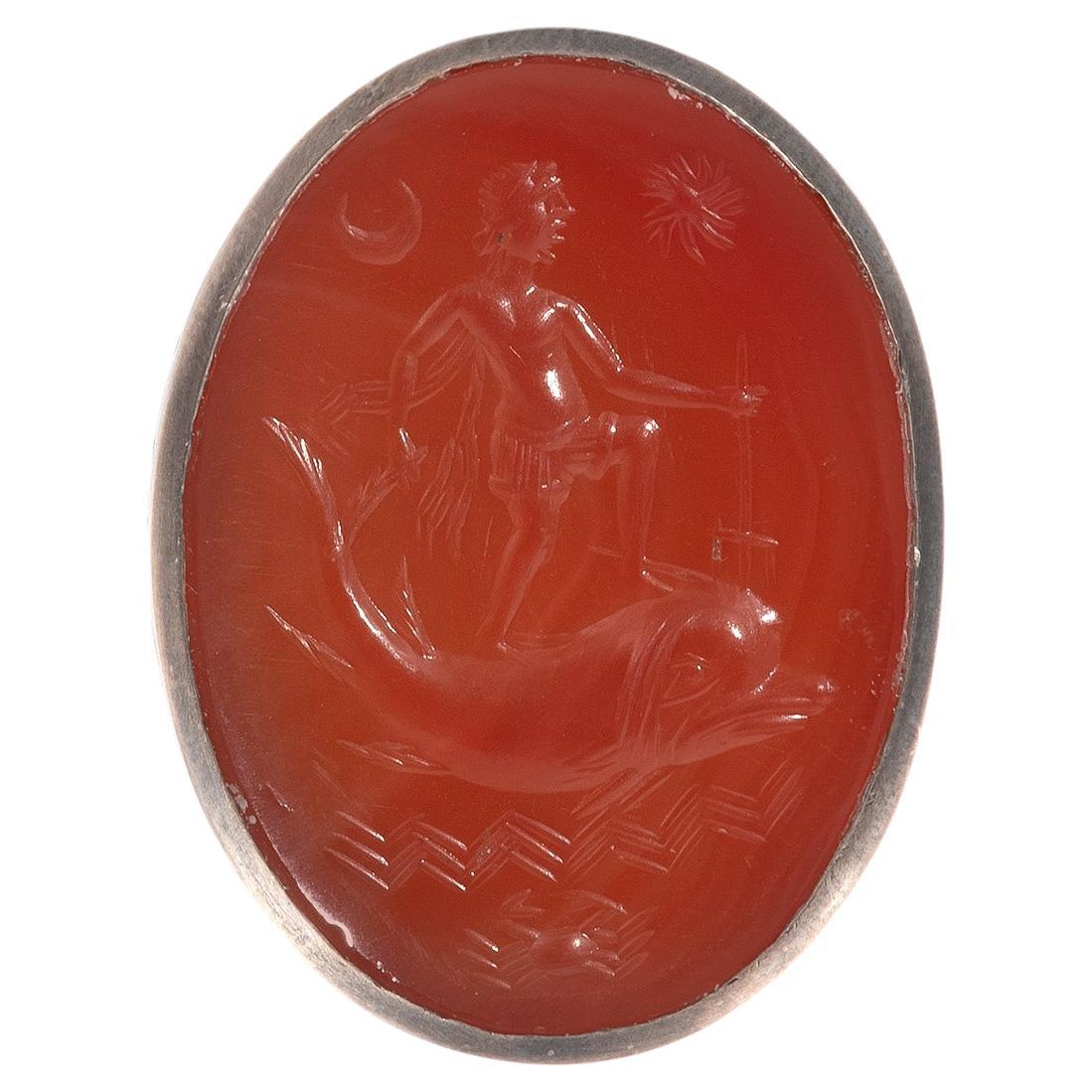Items Similar to C1790 Glass and Carnelian Tassie Intaglio Ring of Laughing Satyr
Video Loading
Want more images or videos?
Request additional images or videos from the seller
1 of 21
C1790 Glass and Carnelian Tassie Intaglio Ring of Laughing Satyr
About the Item
Our C1790 ring is an 18th century glass intaglio of an ancient signed gem depicting the head of a laughing satyr, or faun (a young satyr). Such carvings were called Tassies (explained further down). "Gems" in this case refers not to precious stones, but to ancient classical Greek carvings, highly valued miniature works of art.
Our glass intaglio is signed in Greek for Ammonioy, meaning "by Ammonios". It is not clear that the signature stood for any particular gem engraver; however there are seven gems in the Beazley Archive at the University of Oxford that are signed this way (John Beazley was an archaeologist who left his collection of classical gems to Oxford University). A list of engraver's names from famed German librarian R.E. Raspe's 1790 descriptive catalogue, in which he catalogued James Tassie's vast collection of gem castings, lists the name Ammonios, so it is clear that Raspe believed it to be a genuine signature.
An 18th century example of a laughing satyr of sardonyx can be found in the Beverly collection of Gems at Alnwick Castle. A photo and description of are shown under images.
Glyptic gem engraving is an ancient art form that began in Egypt and later adopted in Greece and Rome. The art of cameo and intaglio sculpting experienced a resurgence in the Middle Ages and Renaissance and again in the eighteenth century, due largely to the discoveries of Herculaneum and Pompeii in Italy.
The gem engraver and merchant James Tassie discovered a technique of making high quality copies of ancient gems in glass. The glass copies were either left transparent or opaque or colored (ours is colored, as one can see). These "perfect copies" were catalogued by RE Raspe in his 1791 descriptive catalogue of gem intaglios and cameos.
In the 18th and early 19th century it became popular for aristocrats to display their collections of cameo and intaglio gems in their homes as a way of conveying their knowledge of classicism, thus building their prestige. Many glass Tassies found their way to Europe through Rome by the collectors who eagerly bought them up as souvenirs on the Grand Tour. It is likely our laughing satyr was acquired in this way.
The ring is glass on the intaglio side and carnelian on the non carved side, called a doublet.
Set to the original 15K collector's mount, the ring is a US size 6 ½.
Resizing is available.
About the Seller
5.0
Vetted Seller
These experienced sellers undergo a comprehensive evaluation by our team of in-house experts.
Established in 1978
1stDibs seller since 2011
300 sales on 1stDibs
Typical response time: 2 hours
- ShippingRetrieving quote...Ships From: Baltimore, MD
- Return PolicyA return for this item may be initiated within 7 days of delivery.
More From This SellerView All
- 18 Karat Reverse Intaglio Crystal Pendant Depicting a Pekingese Dog, circa 1880Located in Baltimore, MD18K pendant of rock crystal with a reverse intaglio of a realistically and beautifully rendered adorable Pekingese. The pendant has an integral matching bale. The reverse side has an...Category
Antique 1880s British Victorian Pendant Necklaces
MaterialsCrystal, 18k Gold
- 18 Karat Georgian Meshwork Tubular Chain Necklace with Barrel Clasp, circa 1790Located in Baltimore, MDOur exceptional 18K Georgian woven mesh featherlight necklace is both light in color and weightless about the neck. Woven mesh chains like this one are ...Category
Antique Early 18th Century British Choker Necklaces
Materials18k Gold
- Antique Gold and Turquoise Quizzing GlassLocated in Baltimore, MDUnique Georgian quizzing glass or quizzer in three color 18K gold set with turquoise in a floral and leaf motif. The elaborate cannetille gold work is kn...Category
Antique 1830s British Georgian More Jewelry
MaterialsTurquoise, 18k Gold
- C1820 Brooch of Mother of Pearl Carving of Gentleman and His Loyal DogLocated in Baltimore, MDEnchanting brooch of cut steel and mother of pearl with carved image of a faithful dog standing at attention as his human companion peacefully angles for a catch under the shade of a tree. The scene is carved from Mother of Pearl and mounted in cut steel. The brooch’s long bar hinge with curved "C" catch helps authenticate indicate its age. Mother of pearl is the iridescent inner shell of mollusks that produce pearls. It has been used to carve decorative objects since ancient times and is the most precious part of the shell. Cut steel was a jewelry form crafted by a cottage industry of men and women (and likely child labor as well) in the 18th and 19th century England. Cut steel was also made in France. Using found materials, this enterprising group of artisans fashioned jewelry from nails which after pounding and polishing and setting, imitated the sparkle of diamonds in the light. Cut steel achieved great popularity as it appealed to people of more moderate means and was the only jewelry form in history that was made by steel workers...Category
Antique 1820s British Victorian Brooches
MaterialsPearl, Cut Steel
- King George III Vauxhall Glass Commemorative BroochLocated in Baltimore, MDRarely seen George III commemorative brooch with George III in profile at the center and decorated with a border of blue and green Vauxhall glass. This historical brooch was thought ...Category
Antique 1780s British George III Brooches
Materials18k Gold, Gilt Metal
- Antique "Queen Anne" Suite of Riviere Necklace and EarringsLocated in Baltimore, MDAmazing "Queen Anne" amethyst paste necklace and earrings set in gilt metal. This style of jewelry was misnamed for Queen Anne, who reigned from 1695 to 1714, as the necklace was mad...Category
Antique 1750s English Georgian Choker Necklaces
MaterialsGilt Metal
You May Also Like
- Roman Intaglio Carnelian RingLocated in New Orleans, LAExceptionally rare and fashioned in the 2nd or 3rd century CE, the carved carnelian gemstone at the center of this ring hails from the Roman Empire. Displaying a rich red color and carved with the image of two Roman deities with a child, the creation exudes the glory of late antiquity. Each taking a classical contrapposto stance, the leftmost god appears crowned with laurels and grasping a staff, while the other appears nude. At their feet, an infant stretches his arms upward toward the divine figures. The crimson carnelian, more than a millennia-old, is set into a later 14K gold ring setting...Category
Antique 15th Century and Earlier European Signet Rings
MaterialsCarnelian, 14k Gold, Yellow Gold
- Georgian Carnelian Intaglio RingLocated in London, GBA Georgian carnelian intaglio ring, the oval carnelian measuring 20 x 17mm, seal engraved with the head of Zeus Ammon, depicted in profile with ram’s horn, ...Category
Antique Early 1800s English Georgian Signet Rings
MaterialsCarnelian
- Carnelian Intaglio Ring, Sailing ShipLocated in Milano, MIRing set in 9ct gold with oval intaglio on carnelian depicting a sailing ship. Highlights - Carnelian intaglio depicting a sailing ship - 9ct gold 375 - ...Category
Mid-20th Century British Signet Rings
MaterialsCarnelian, 9k Gold
- Antique Gold and Carnelian Intaglio Signet RingLocated in Chicago, ILCirca 1910 14k Yellow Gold Intaglio Signet Ring, the top measures 9/16 X 9/16 inch and is set with a dark Red Ancient Greek - Roman style Intaglio. Hand chased design work on the si...Category
Vintage 1910s American Edwardian Signet Rings
MaterialsCarnelian, Gold, 14k Gold
- Carnelian Intaglio Silver Ring BullLocated in Milano, MICarnelian intaglio ring set in silver depicting a bull. Highlights - Carnelian - Silver ring setting Measurements - Length 1.9cm x Width 2.2cm -...Category
20th Century Signet Rings
MaterialsCarnelian, Silver
- Large Silver and Carnelian Intaglio Men's RingLocated in Firenze, ITCarnelian depicting Neptune on his chariot drawn by dolphins mounted in silver ring. Top size 33mm x 26mm Size: 9 3/4 Weight: 21,64gr.Category
Antique Late 19th Century Italian Victorian Signet Rings
MaterialsCarnelian, Silver
Recently Viewed
View AllMore Ways To Browse
Ancient Cameo Ring
Ancient Greek Gold Intaglio Ring
18th Century Gold Signet Ring
Glass Signet Ring
Renaissance Intaglio
Signet Ring E
18Th Century Antique Signet Ring
Gold Signet E
Gold Signet Ring E
Antique Castle Rings
Antique Jewelry Oxford
Antique 18th Century Gold Signet Ring
Souvenir Ring
Intaglio Ring Georgian
18k Gold Ring Greece Carnelian
Satyr Jewelry
18th Century Cameo Rings
Antique Sardonyx Ring





